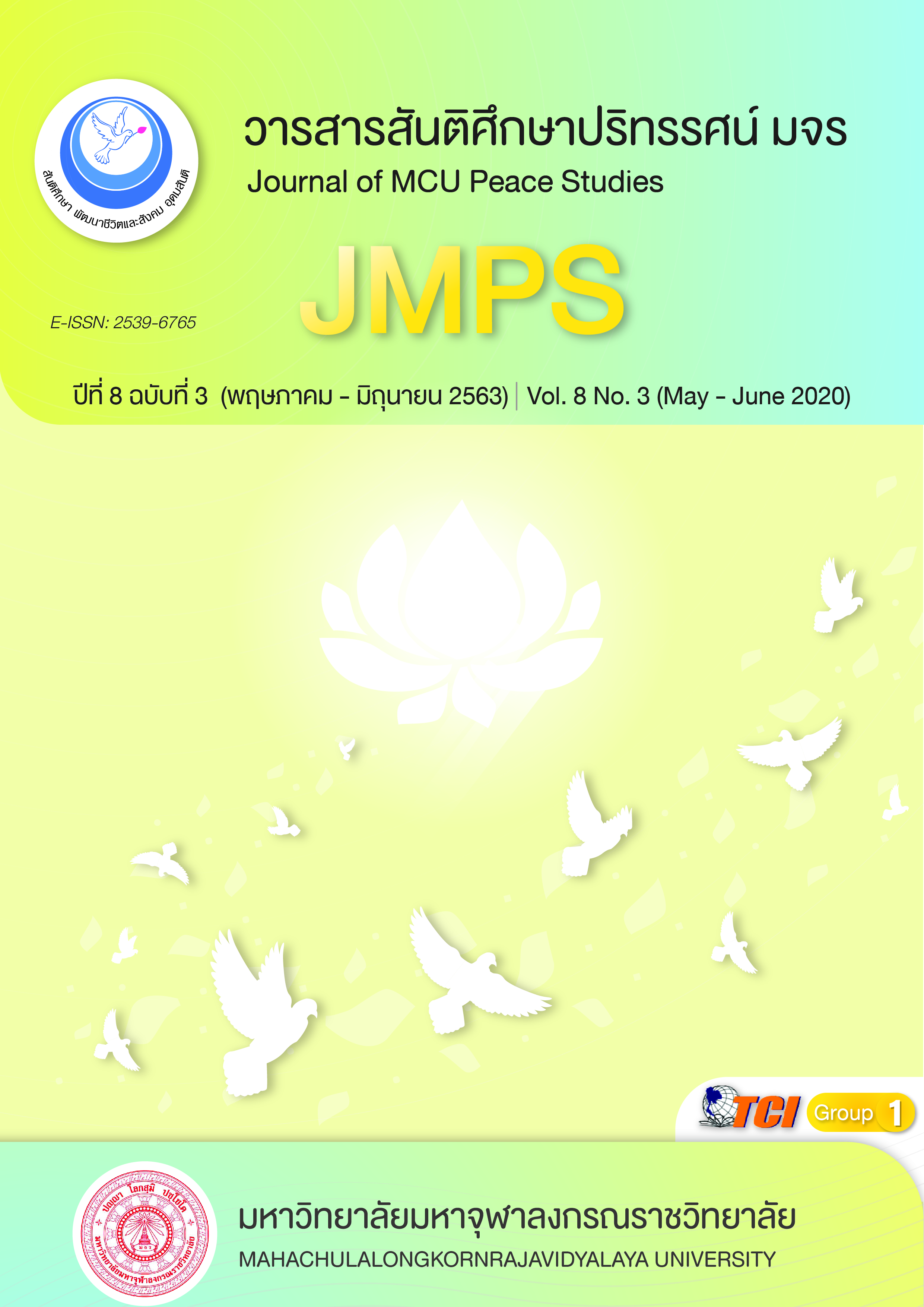การศึกษาทักษะการแก้ปัญหาเชิงสร้างสรรค์ สำหรับนักศึกษาคณะครุศาสตร์ มหาวิทยาลัยราชภัฏกลุ่มภาคกลางตอนบน
Main Article Content
บทคัดย่อ
การวิจัยครั้งนี้มีวัตถุประสงค์เพื่อ ประเมินสภาพปัจจุบันและสภาพความคาดหวังของทักษะการแก้ปัญหาเชิงสร้างสรรค์ สำหรับนักศึกษาคณะครุศาสตร์ มหาวิทยาลัยราชภัฏกลุ่มภาคกลางตอนบน โดยใช้วิธีการวิจัยแบบผสมผสาน ประกอบด้วยการสัมภาษณ์เชิงลึก และ การประเมินสภาพปัจจุบัน และสภาพความคาดหวัง กลุ่มตัวอย่างที่ใช้ในการวิจัยครั้งนี้ แบ่งเป็น 2 กลุ่ม ดังนี้ กลุ่มตัวอย่างที่ใช้ในการสัมภาษณ์เชิงลึก คือ ผู้บริหาร ครูพี่เลี้ยง และอาจารย์ผู้สอนในมหาวิทยาลัยราชภัฏกลุ่มภาคกลางตอนบน 5 แห่ง ในปีการศึกษา 2562 จำนวน 20 คน กลุ่มตัวอย่างที่ใช้ในการประเมินสภาพปัจจุบัน และสภาพความคาดหวัง คือ นักศึกษาคณะครุศาสตร์ มหาวิทยาลัยราชภัฏกลุ่มภาคกลางตอนบน ปีการศึกษา 2562 จำนวน 326 คนเครื่องมือที่ใช้ในการวิจัย ได้แก่ แบบสัมภาษณ์เชิงลึก และประเมินสภาพปัจจุบันและสภาพความคาดหวัง วิเคราะห์ข้อมูลโดยใช้การอธิบายผลการสัมภาษณ์จากการวิเคราะห์เชิงพรรณนา และการวิเคราะห์ข้อมูลโดยใช้ค่าร้อยละ ค่าเฉลี่ย ค่าเบี่ยงเบนมาตรฐาน และเรียงลำดับความสำคัญของข้อมูลด้วยค่า Modified Priority Needs Index: PNIModified ผลการวิจัยพบว่า ผู้บริหาร ครูพี่เลี้ยง และอาจารย์ผู้สอน มีความคิดเห็นว่าทักษะการแก้ปัญหาเชิงสร้างสรรค์ของนักศึกษานักศึกษาคณะครุศาสตร์ มหาวิทยาลัยราชภัฏกลุ่มภาคกลางตอนบน มีระดับความสามารถในระดับต่ำ ควรได้รับการพัฒนาและเสริมสร้างทักษะดังกล่าว และระดับความต้องการจำเป็นของทักษะการแก้ปัญหาเชิงสร้างสรรค์ สำหรับนักศึกษาคณะครุศาสตร์ มหาวิทยาลัยราชภัฏกลุ่มภาคกลางตอนบน ด้านการสำรวจปัญหา สูงที่สุด รองลงมาคือ ด้านการสร้างความคิดสร้างสรรค์ ด้านการค้นหาความจริง ด้านการดำเนินการแก้ปัญหาอย่างสร้างสรรค์ และด้านการเลือกวิธีการอย่างสร้างสรรค์ ตามลำดับ
Article Details
ทัศนะและความคิดเห็นที่ปรากฏในบทความในวารสาร ถือเป็นความรับผิดชอบของผู้เขียนบทความนั้น และไม่ถือเป็นทัศนะและความรับผิดชอบของกองบรรณาธิการ ยินยอมว่าบทความเป็นลิขสิทธิ์ของวารสาร
เอกสารอ้างอิง
Auth, P. (2005). Assessing the use of creative problem-solving skills and generic influences on learning in clinical reasoning by physician assistant students. Ph.D. Dissertation. Drexel University.
Cusin, P. (1996). Action Learning Revisited. Employee Counselling Today, 8(6), 21-28.
Eubanks, Murphy & Mumford. (2010). Intuition as an Influence on Creative Problem Solving: The Effects of intuition, Positive Affect, and Training. Creativty Research Journal of Abnormal Psychology, 22(2), 170-184.
Guilford, J. P. (1954). Psychometric method: Tata: McGrow-Hill.
Harris, R. A. (2002). Creative Problem Solving. A Step-by-Step Approach: Los Angeles. Institute Faculty and educational personnel.
Jokonya, O. (2016). Towards a Critical Systems Thinking Approach during IT Adoption in Organisations. Procedia Computer Science, 100(Supplement C), 856-864. Retrived January 25, 2020, from https://doi.org/101016/_procs 2016.09235.
Khemmanee, T. (2001). Thinking Science. Bangkok: Teacher Development
Mitchell, W & Kowalik, T. (1999b). Creative Problem Solving. n.p: Unpublished workbook.
Mitchell, W. E. & Kowalik, T. F. (1999a). Creative problem solving. Retrived February 20, 2020, from http://www.creativeeducationfoundation.org/creative-problem-solving/
Na Ayutthaya, P. (1995). Barriers to creative problem solving. Journal of Education, 24 (2), 31-40.
National Institute for Development of Teachers, Faculty Staff and Educational Personnel. (2007). Research on experimental model development of teacher-based model Area as a base and policy recommendations and teacher development strategies. Bangkok: Cabinet Press and the Government Gazette.
Office of the Higher Education Commission. (2009). National Qualifications Framework for Higher Education 2009: Meeting documents number 1.
Orrance, E.P. (1973). Encouraging creativity in the classroom. (4th ed.). USA: Wm. C. Brown Company Publishes.
Osborn, A. F. (1957). Applied the imagination: principles and procedure of creativethinging New York: Scribner.
Osburm, H. K. & Mumford, M. D. (2006). Creativily and Planning: Training Interventions to Develop Creative Problem-Solving Skills. Creativity Research Journal, 18(2), 173-190.
Piyaputto, P. Boonpoo, S & Thitavaddhang, P. (2019). A Model of Teachers' Skills Development in Temple Education Welfare Schools in Sangha Administrative Region 1. Journal of MCU Journal of MCU Peace Studies, 7(5), 1298.
Saiyot, L. & Saiyot, A. (1996). Educational research techniques. Bangkok: Suwiriya.
Sinlarat, P. (2016). Thai education 4.0 is much better than Thai education. Bangkok: Chulalongkorn University.
Sukkasem, K. (2017). Graduate employment status and the satisfaction of the entrepreneurs and graduate users who have Bachelor of Education Valaya Alongkorn Rajabhat University. Pathum Thani: Valaya Alongkorn Rajabhat University.
Tanthikul, R. (2016). The satisfaction of users of the Faculty of Education Phranakhon Si Ayutthaya Rajabhat University Phra Nakhon Si Ayutthaya. Phra Nakhon Si Ayutthaya: Phra Nakhon Si Ayutthaya Rajabhat University.
Thapanaphrapa, P. (2005). Applied psychology in life and work. Bangkok: Pornnares.
The Secretariat of the Council of Education. (2015). Status of teacher production and development in Thailand. Bangkok: Prig Wan Graphic.
Thongton, A. (2016). Graduate user satisfaction with the performance and identity of graduates. Research report.
Thongying, C. (2016). Teacher Problems: Problems Waiting Reform. Retrieved May 5, 2019, from http://library2.parliament.go.th/ebook/content-issue/2016/2016/hi2559-091.
Torrance, E.p. (1965). Helping Gifted Children Become Creative Readers, Gifed Children in the Classroom. New York: Macmillan.
Treffinger, D. Sellby, E. & Isaksen, S. G. (2008). Understanding individual problem Solving Style: A key to learning and applying Creative problem solving. Learning and Individual Differences, 18(4), 390-401.
Treffinger. (2004). Creative problem solving: An Introduction. Texas: Prufrock Press.


